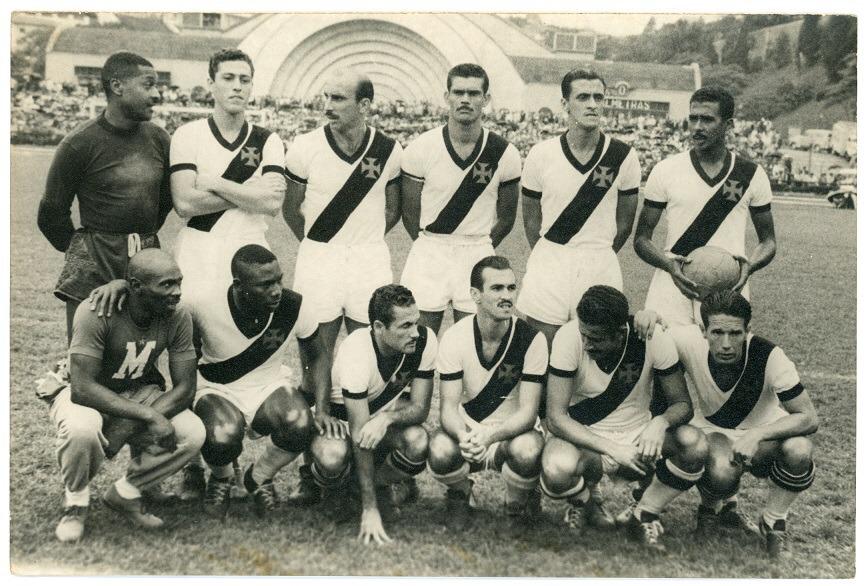Moacyr Barbosa was born on 27 March 1921 in the city of Campinas. This child would go on to become the famous goalkeeper Barbosa, one of the star players of the “Vitória Express”, the nickname given to the Vasco da Gama team that won a whole string of titles in the 1940s. Barbosa was also the main goalkeeper of the Brazilian team during the 1950 World Cup.

Like other highly talented black players, Barbosa rapidly became a football icon of his time. He began his career in São Paulo, made a name for himself at CA Ypiranga and moved to Vasco da Gama in 1945. Lithe, versatile and capable of positioning himself well in the box, Barbosa was also known for his good humor and charisma. This gained him much renown in the local press, which avidly followed his career.
Selection the 1950 World Cup Finals squad dramatically increased media coverage of Barbosa, but, when Schiaffino and Ghiggia put the ball past him to win the title for Uruguay, the plaudits came to an end. Over time, the goalkeeper came to be seen first and foremost as one of those who—if not the main culprit—was most to blame for the defeat.
In the decades that followed, a stream of documentaries, newspaper reports, photographs and even feature films reproduced images not only of Barbosa picking himself up after failing to reach the ball driven past him by Ghiggia, but also of players and fans in tears at the end of the game. The reproduction of these images had (and continue to have) a powerful influence on the way people see and understand that moment in time.

It was years before it became possible to expose the racial discrimination implicit in this narrative, which, sadly, became the prevailing interpretation.
This narrative was, in fact, associated with a certain cultural and political stereotype, emerging in the early 20th century, whereby black people’s contribution to society was seen primarily in terms of a restricted role in the worlds of sport and entertainment. According to this stereotype, images of men and women of color appeared as symbols designed to entertain or enchant the middle and upper classes of society. Any failure to live up to this expected role sparked even harsher racial discrimination.
This explains why the World Cup runners-up title of 1950, the six State championship titles won by Vasco da Gama and the extraordinary achievement of being crowned South American Champions in 1949 are not seen as the highlights of Barbosa’s career. Much the same can be said of the way today’s players are treated in the sports pages of newspapers as either heroes or villains, irrespective of their careers as a whole.
While it took a long time and great effort to expose the racist narrative underlying reporting of the 1950 World Cup defeat, the same can also be said for attempts to view this story in an anti-racist way. In the year in which we celebrate the centenary of Moacyr Barbosa’s birth, the Football Museum has attempted to help provide just such a perspective by putting on a temporary exhibition dedicated to this talented goalkeeper. Scheduled to open at the end of the first half of 2021, the exhibition takes a fresh look at Barbosa’s career and, through him, that of other black football stars. The history of football has much to gain from paying greater homage to this extraordinary player.
Find out more about Barbosa:
- ABRAHÃO, Bruno Otávio de Lacerda; SOARES, Antonio Jorge Gonçalves. O que o brasileiro não esquece nem a tiro é o chamado frango de Barbosa: questões sobre o racismo no futebol brasileiro. Movimento, Porto Alegre, v. 15, n. 2, 2009. https://museudofutebol.org.br/crfb/acervo/578524/
- DREWNICK, Raul. O goleiro fantasma. São Paulo: Lazuli; Companhia Editora Nacional, 2011. 176 p. https://museudofutebol.org.br/crfb/acervo/586499/
- FREITAS, Bruno. Queimando as traves de 50: glórias, castigo de Barbosa, maior goleiro da era romântica do futebol brasileiro. Rio de Janeiro: iVentura, 2013. https://museudofutebol.org.br/crfb/acervo/588096/
- MORAES NETO, Geneton. Dossiê 50: um repórter em busca dos onze jogadores que entraram em campo para serem campeões do mundo em 1950, mas se tornaram personagens do maior drama da história do futebol brasileiro. Rio de Janeiro: Maquinária, 2013. 158 p. https://museudofutebol.org.br/crfb/acervo/588096/
- MESQUITA, Alexandre; ALMEIDA, Jefferson. Um expresso chamado vitória. Rio de Janeiro: iVentura, 2010. 238 p. https://museudofutebol.org.br/crfb/acervo/535585/
- SIMON, Luís Augusto. Os 11 maiores goleiros do futebol brasileiro. São Paulo: Contexto, 2010. 256 p. https://museudofutebol.org.br/crfb/acervo/527454/
- SOUTO, Sergio Montero. Os três tempos do jogo: anonimato, fama e ostracismo no futebol brasileiro Rio de Janeiro: Graphia, 2000. 99 p. https://museudofutebol.org.br/crfb/acervo/495066/
- MUYLAERT, Roberto. Barbosa, um gol faz 50 anos. São Paulo: RMC, 2000. 221 p. https://museudofutebol.org.br/crfb/acervo/501484/
- MUYLAERT, Roberto. Barbosa, um gol silencia o Brasil. – São Paulo: Bússula, 2013. 220 p. https://museudofutebol.org.br/crfb/acervo/528514/
- TAVES, Rodrigo; NOGUEIRA, Cláudio. Os dez mais do Vasco da Gama. Rio de Janeiro: Maquinária, 2011. 184 p. https://museudofutebol.org.br/crfb/acervo/508661/
- VASCONCELLOS, Jorge. Recados da bola: doze depoimentos dos mestres do futebol brasileiro. São Paulo: Cosac Naify, 2010. 240 p. https://museudofutebol.org.br/crfb/acervo/527832/
Diana Mendes
Brazilian Football Reference Center – Coordinator


